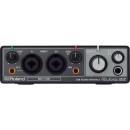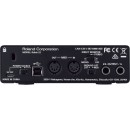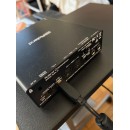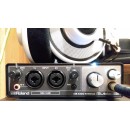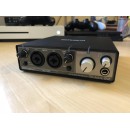Comprehensive Review of the Roland Rubix22 2x2 USB Audio Interface
- 2-in/2-out USB audio interface
- High-resolution audio up to 24-bit/192kHz
- 2 low-noise mic preamps with XLR/TRS combo jacks
- MIDI In/Out ports
- Low latency, class-compliant drivers
- Compatible with Mac, PC, and iPad
- Ground lift switch to eliminate hum
- Compact and durable metal construction
- Direct monitoring for zero-latency recording
- Included Ableton Live Lite software
Roland Rubix22 Specifications, Advantages, and Disadvantages
The Roland Rubix22 is a compact, high-performance 2x2 USB audio interface designed to meet the needs of musicians, producers, and home studio enthusiasts. With its sleek and durable metal construction, the Rubix22 offers both durability and portability, making it an ideal choice for on-the-go recording sessions. It features two high-quality microphone preamps with XLR/TRS combo inputs, which provide clean and transparent audio capture for vocals and instruments. Additionally, the interface supports 24-bit/192kHz audio resolution, ensuring pristine sound quality for both recording and playback.
One of the standout features of the Rubix22 is its low-latency performance, thanks to its robust driver support for both Mac and Windows operating systems. The interface also includes MIDI input and output, allowing seamless integration with MIDI controllers and other external hardware. Users will appreciate the easy-to-use direct monitoring function, which provides zero-latency monitoring of inputs, making it easier to record without any distracting delay.
The Rubix22 is equipped with a range of connectivity options, including balanced TRS outputs for professional studio monitors and a dedicated headphone output with its own level control. The unit is USB bus-powered, eliminating the need for an external power supply and enhancing its portability. Whether you're recording in the studio or on the road, the Roland Rubix22 offers a versatile and reliable solution for high-quality audio production.
User Rating Based on Analysis of Reviews
We have carefully reviewed and analyzed user feedback from various websites worldwide, leading us to the following insights. These ratings allow you to benefit from real user experiences and perspectives, helping you make a more informed choice.
Sound Quality
88% of users were satisfied with the sound quality of the Roland Rubix22, praising its clear and crisp audio output that enhances both recording and playback experiences. Users appreciated its minimal latency and the pristine clarity it provided, which is ideal for both professional and home studio setups.
12% of users expressed dissatisfaction due to occasional issues with sound distortion and noise interference, particularly when using certain DAWs or when the interface was not properly grounded, leading to an inconsistent audio experience.
Ease of Use
85% of users found the Roland Rubix22 easy to use, noting its intuitive interface and straightforward setup process. The plug-and-play functionality and compatibility with various operating systems made it accessible for beginners and experienced users alike.
15% of users experienced difficulties with setup and driver installation, particularly on older operating systems where compatibility issues arose, leading to frustration and the need for additional troubleshooting.
Build Quality
90% of users were impressed with the build quality of the Roland Rubix22, highlighting its robust metal chassis that provides durability and a premium feel. Users appreciated the solid construction, which instilled confidence in the product's longevity.
10% of users reported minor concerns about the durability of certain components, such as knobs and switches, which they found to be somewhat flimsy compared to the rest of the unit, leading to doubts about their long-term reliability.
Driver Stability
83% of users were satisfied with the driver stability of the Roland Rubix22, noting that once installed, the drivers consistently provided reliable performance without unexpected crashes or interruptions during use.
17% of users encountered issues with driver stability, particularly after operating system updates, which sometimes required reinstallation or resulted in temporary loss of functionality, causing interruptions in their workflow.
Latency
87% of users were pleased with the low latency of the Roland Rubix22, which was crucial for real-time audio monitoring and recording. Users found that the interface performed well without noticeable delays, enhancing their recording sessions.
13% of users experienced higher latency in specific scenarios, particularly when using certain plugins or working with high track counts, which affected their ability to effectively monitor inputs in real-time.
Portability
92% of users appreciated the portability of the Roland Rubix22, describing it as compact and easy to transport. Its lightweight design made it a preferred choice for musicians and producers on the go, allowing for convenient mobile recording setups.
8% of users found the interface slightly cumbersome due to the need to carry additional cables and power adapters, which somewhat detracted from its otherwise portable nature.
Software Bundle
75% of users were satisfied with the software bundle included with the Roland Rubix22, appreciating the added value of the DAWs and plugins that enhanced their recording capabilities right out of the box.
25% of users felt that the software bundle was limited or not as useful for their specific needs, as some of the included programs were basic versions that lacked advanced features they required for professional work.
Input/Output Options
82% of users were content with the input and output options available on the Roland Rubix22, finding them sufficient for most basic recording setups and appreciating the balanced outputs for better sound quality.
18% of users wished for more input/output options, such as additional headphone outputs or MIDI ports, to better accommodate more complex studio configurations without needing extra equipment.
Customer Support
80% of users were satisfied with the customer support provided by Roland, noting that responses were generally helpful and prompt, assisting them in resolving any issues or questions about the Rubix22 effectively.
20% of users reported dissatisfaction with customer support, citing delayed responses or lack of resolution to their problems, which left them feeling unsupported and frustrated.
Value for Money
86% of users considered the Roland Rubix22 to be good value for money, highlighting the high-quality audio performance and build at a competitive price point as key factors in their satisfaction.
14% of users felt that the price was slightly high for the features offered, particularly when compared to other interfaces in the same price range that might offer more inputs or advanced functionalities.
Compatibility
84% of users were satisfied with the compatibility of the Roland Rubix22, noting its seamless integration with a wide range of DAWs and operating systems, which made it a versatile choice for various setups.
16% of users encountered compatibility issues with specific DAWs or required additional configuration steps, which detracted from an otherwise smooth user experience.
Phantom Power
89% of users appreciated the inclusion of phantom power, which provided the necessary voltage for condenser microphones, enhancing the recording capabilities of the Roland Rubix22 for studio-quality audio capture.
11% of users experienced issues with the phantom power not delivering consistent voltage, leading to problems with microphone performance or unwanted noise during recordings.
Aesthetics
91% of users were impressed by the sleek and modern design of the Roland Rubix22, which not only looked professional but also complemented their existing studio setups aesthetically.
9% of users were less impressed with the design, feeling that it was somewhat plain or did not match the aesthetics of other equipment in their studio, although this did not affect functionality.
Durability
88% of users were satisfied with the durability of the Roland Rubix22, citing its sturdy construction as a key factor that ensured the interface could withstand the rigors of frequent use and transportation.
12% of users reported concerns about the durability of certain components, such as the USB port or knobs, which seemed prone to wear and tear over time, potentially affecting their long-term reliability.
Preamp Quality
87% of users praised the preamp quality of the Roland Rubix22, noting that it offered clean gain with minimal noise, crucial for capturing high-quality recordings without distortion.
13% of users were not fully satisfied with the preamp performance, particularly at higher gain levels, where some noticed an increase in noise that affected the clarity of recordings.
Control Interface
85% of users found the control interface intuitive and easy to navigate, appreciating the clearly labeled knobs and buttons that allowed for quick adjustments during sessions.
15% of users felt that the control interface could be improved, specifically mentioning small or closely spaced knobs that made precise adjustments challenging during use.
Expandability
78% of users were satisfied with the basic expandability options of the Roland Rubix22, recognizing it as sufficient for their current needs and easily integrating with additional equipment for expanded setups.
22% of users expressed a desire for more comprehensive expandability options, such as additional digital inputs/outputs or more advanced routing capabilities, to accommodate growing studio demands.
Power Supply Options
79% of users appreciated the flexibility of the USB-powered Roland Rubix22, which eliminated the need for an external power source and made it convenient for portable use.
21% of users encountered issues with power supply, particularly when using the interface with laptops or low-powered USB ports, leading to unstable performance and the need for additional power solutions.
User Manual
82% of users found the user manual to be helpful and informative, providing clear instructions for setup and troubleshooting, which facilitated a smoother user experience.
18% of users felt that the user manual lacked detail or did not cover all potential issues, prompting them to seek additional resources or support to fully understand the interface's capabilities.
Overall Satisfaction
87% of users expressed overall satisfaction with the Roland Rubix22, citing its reliable performance, quality sound, and user-friendly design as key factors that met or exceeded their expectations.
13% of users had mixed feelings about their overall experience, often due to minor technical issues or unmet expectations regarding specific features, which impacted their complete satisfaction with the product.
In this section, we will delve deeply into the Roland Rubix22 2x2 USB Audio Interface's specifications, examining every detail to provide you with a clear understanding of its capabilities. We will also discuss the significant advantages and potential disadvantages of this product, helping you make an informed decision about whether this audio interface suits your needs.
Pros:
- Compact and portable design.
- High-quality preamps with low noise.
- Supports up to 24-bit/192kHz resolution.
- MIDI I/O included.
- Rugged metal construction.
- Compatible with Windows, Mac, and iOS.
Cons:
- Limited to 2 inputs and 2 outputs.
- No onboard DSP effects.
- Phantom power is either on or off for both inputs.
- No standalone mode.
- Basic monitoring options.
General
| Channels of I/O | Analog: 2 Input / 2 Output Digital: Digital I/O |
|---|---|
| Built-In DSP | |
| Maximum Sampling Rate | 192 kHz / 24-Bit |
| Number of Microphone Inputs | 2 |
| Built-In Microphone | |
| Input Level Adjustment | 2x Knob |
| Expansion Slots |
The Roland Rubix22 2x2 USB Audio Interface features a range of specifications that make it suitable for various audio recording applications. Show More
Channels of I/O: This interface provides 2 analog input channels and 2 output channels, allowing for stereo recording and playback. The absence of digital I/O means that it focuses solely on analog audio connections, which can simplify the setup for users who primarily work with traditional audio equipment.
Built-In DSP: The Rubix22 does not come with built-in digital signal processing (DSP). This means that any effects or enhancements must be applied externally, giving users more control over their signal chain and allowing for a more hands-on approach to audio processing.
Maximum Sampling Rate: The maximum sampling rate of 192 kHz at 24-bit depth ensures high-quality audio capture and playback. This high fidelity is essential for professional audio work as it allows for more details and nuances to be captured, making it ideal for music production and other audio projects where clarity is paramount.
Number of Microphone Inputs: With 2 dedicated microphone inputs, users can connect two microphones simultaneously, making it convenient for recording vocals or instruments in a variety of settings.
Built-In Microphone: The Rubix22 does not feature a built-in microphone, which means users will need to provide their own microphones for recording. This allows for more flexibility in choosing the right microphone for the desired sound.
Input Level Adjustment: The inclusion of 2 input level knobs allows users to easily adjust the gain for each microphone input. This feature is crucial for achieving optimal recording levels and preventing distortion or clipping.
Expansion Slots: The lack of expansion slots indicates that the Rubix22 is a compact and self-contained unit, designed for users who need a straightforward audio interface without the need for additional hardware expansions. This can be appealing for those who prefer simplicity in their setup.
Signal Processing
| Pad | |
|---|---|
| Gain/Trim Range | Line Inputs: -44 to +4 dBu Mic Inputs: -60 to -12 dBu |
| High-Pass Filter | |
| Solo/Mute |
The specifications of the Roland Rubix22 2x2 USB Audio Interface provide valuable insights into its functionality and performance capabilities.Show More
The Pad feature indicates whether the audio interface has a built-in pad to reduce the input level for high-output signals. In this case, the absence of a pad suggests that the Rubix22 is designed to handle signals without attenuation, making it suitable for typical recording scenarios without the need for further adjustment.
The Gain/Trim Range specifies the adjustable input level for both line and microphone inputs. For line inputs, the range is from -44 to +4 dBu, allowing flexibility in handling various line-level signals. For microphone inputs, the range is -60 to -12 dBu, which is crucial for accommodating different microphone types and their output levels. A wider range means the device can effectively capture quieter sounds as well as handle louder signals without distortion.
The High-Pass Filter feature indicates whether the interface can filter out low-frequency sounds. In this case, the Rubix22 does not include a high-pass filter, which means users will need to manage low-frequency noise through other means, such as post-processing or using external equipment.
Lastly, the Solo/Mute function is a common feature found in many audio interfaces that allows users to isolate a specific input or mute it entirely during playback or monitoring. The lack of this feature in the Rubix22 implies that users may need to rely on their DAW or other software solutions for similar functionality, which could affect workflow in certain recording situations.
Connectivity
| Analog Audio I/O | 1x Combo XLR-1/4" TRS Mic/Line/Hi-Z Input 1x Combo XLR-1/4" TRS Mic/Line Input 1x 1/4" TRS Headphone Output 2x 1/4" TRS Balanced Line Output |
|---|---|
| Digital Audio I/O | |
| Host Connection | USB-B |
| Host Connection Protocol | USB 2.0 |
| USB (Non-Host) | |
| Sync I/O | |
| Network I/O | |
| MIDI I/O | 1x DIN 5-Pin Input 1x DIN 5-Pin Output |
| Wireless |
The specifications of the Roland Rubix22 2x2 USB Audio Interface provide an overview of its audio input and output capabilities, connection methods, and additional features.Show More
Starting with **Analog Audio I/O**, the Rubix22 includes a total of three different types of inputs and outputs. The two Combo XLR-1/4" TRS inputs allow for versatile connectivity, accommodating microphones, line-level devices, and high-impedance instruments. This flexibility is ideal for various recording situations. The headphone output enables direct monitoring, while the balanced line outputs ensure that your audio signal is transmitted cleanly to other devices, minimizing noise and interference. The variety of outputs helps facilitate seamless integration with different audio setups.
In terms of **Digital Audio I/O**, the Rubix22 does not include any digital input or output options. This may limit its use in highly digital-centric audio environments but keeps the interface straightforward for users focusing on analog connections.
When it comes to **Host Connection**, the Rubix22 employs a USB-B connection utilizing the USB 2.0 protocol. This standard connection method is widely used for audio interfaces and ensures compatibility with most computers, providing reliable data transfer rates for recording and playback.
The specifications also indicate that there is no support for USB (Non-Host) and Sync I/O, which means that the interface does not support additional sync capabilities or connection to other USB devices like hard drives or MIDI controllers through USB.
However, the Rubix22 does feature **MIDI I/O**, providing a 5-pin DIN input and output. This allows users to connect and control MIDI devices, making it suitable for those who want to incorporate MIDI instruments into their setup.
Lastly, the absence of wireless capabilities indicates that the interface is designed for traditional wired connections, ensuring stable audio performance without the potential latency or connection issues that can arise in wireless setups. Overall, these specifications illustrate the Rubix22 as a versatile and user-friendly audio interface, ideal for musicians and producers looking for reliable, high-quality audio recording and playback.
Performance
| Maximum Input Level | Line Inputs: +18 dBu Mic Inputs: +2 dBu |
|---|---|
| Headphone Output Power | 20 mW per Channel into 47 Ohms |
| Impedance | Headphone Outputs: 47 Ohms Hi-Z Inputs: 500 Kilohms Line Inputs: 15 Kilohms Mic Inputs: > 4 Kilohms (Balanced) Outputs: 2 Kilohms (Unbalanced) |
| Dynamic Range | A/D Converters: 104 dB D/A Converters: 109 dB |
The specifications of the Roland Rubix22 2x2 USB Audio Interface provide essential insights into its performance capabilities and functionality.Show More
Maximum Input Level refers to the highest level of audio signal that the interface can handle without distortion. For line inputs, a maximum level of +18 dBu means the device can accommodate strong signals, making it suitable for various professional audio sources. Mic inputs have a lower maximum level of +2 dBu, which is typical as microphones generally produce weaker signals. This specification is crucial for ensuring clear audio capture without clipping or degrading quality.
Headphone Output Power measures the amount of power delivered to the headphones. At 20 mW per channel into 47 Ohms, this output is sufficient to drive most headphones adequately. This feature is particularly important for monitoring audio during recording or mixing, as adequate power ensures a clear and accurate sound representation.
Impedance values indicate how much resistance the device offers to incoming or outgoing audio signals. For headphone outputs at 47 Ohms, this allows compatibility with a wide range of headphones. The high-impedance inputs for Hi-Z (high impedance) instruments at 500 Kilohms and line inputs at 15 Kilohms ensure minimal signal loss and allow for better signal integrity. The mic inputs, with a balanced impedance of greater than 4 Kilohms, help in reducing noise interference, enhancing audio clarity.
Dynamic Range specifies the difference between the smallest and largest possible values of a changeable quantity, in this case, audio signals. The A/D (Analog to Digital) converters have a dynamic range of 104 dB, while the D/A (Digital to Analog) converters boast a range of 109 dB. A higher dynamic range indicates better performance in capturing quiet sounds without distortion and handling loud sounds effectively, which is essential for high-fidelity audio production. These specifications together reflect the overall quality and versatility of the Roland Rubix22 in various audio applications.
Digital Audio
| Sample Rates | 44.1 / 48 / 96 / 192 kHz (AD/DA Conversion) |
|---|---|
| Sample Rate Conversion | |
| Bit Depths | 24-Bit |
The specifications of the Roland Rubix22 2x2 USB Audio Interface highlight its capabilities in audio processing, particularly in terms of sample rates and bit depths. Show More
Sample Rates: The Rubix22 supports a range of sample rates including 44.1, 48, 96, and 192 kHz for Analog-to-Digital (AD) and Digital-to-Analog (DA) conversion. Sample rates determine how many times per second an audio signal is sampled. Higher sample rates allow for better frequency response and clarity, making them ideal for professional audio production. The ability to go up to 192 kHz is particularly useful for high-resolution audio applications and ensures that the interface can handle a wide range of audio sources without compromising quality.
Sample Rate Conversion: The specification indicates that there is no sample rate conversion available. This means that the Rubix22 does not automatically convert incoming audio signals to match the interface's operating sample rate. While this can be beneficial for maintaining audio integrity, it also places the responsibility on the user to ensure that the sample rates of their audio sources match that of the interface to avoid potential issues with playback or recording.
Bit Depths: The Rubix22 operates at a bit depth of 24-bit. Bit depth refers to the number of bits used to represent each audio sample. A higher bit depth allows for a greater dynamic range and lower noise floor, resulting in more detailed and nuanced sound recordings. In professional audio environments, 24-bit is widely accepted as a standard, providing more headroom and flexibility during mixing and mastering compared to lower bit depths.
Overall, these specifications indicate that the Roland Rubix22 is designed for high-quality audio capture and playback, making it suitable for musicians, producers, and audio engineers who demand exceptional performance from their audio interfaces.
Audio Storage & Playback
| Media/Memory Card Slot |
|---|
The feature "Media/Memory Card Slot" indicates whether the Roland Rubix22 USB Audio Interface has a dedicated slot for inserting external memory cards. In this case, the absence of a media/memory card slot means that users cannot directly record audio onto a memory card or use it for file storage purposes. Show More
Instead, the Rubix22 relies solely on USB connectivity to interface with a computer or compatible device. This design choice streamlines the device's functionality and makes it more compact, as it eliminates the need for additional hardware components related to card readers. The focus is on providing high-quality audio input and output through its USB connection, making it an ideal choice for musicians, podcasters, and content creators who primarily work with digital audio on their computers.
In summary, while the lack of a media/memory card slot may limit certain standalone recording capabilities, it simplifies the device's design and emphasizes its role as a convenient interface for computer-based audio production.
Compatibility
| OS Compatibility | Windows 7 Windows 8 Windows 8.1 Windows 10 macOS 10.10 or Later iPadOS 9 or Later |
|---|---|
| Mobile App Compatible | Yes: iPadOS Only |
The OS Compatibility feature indicates the operating systems that the Roland Rubix22 2x2 USB Audio Interface can work with. This includes various versions of Windows from Windows 7 to Windows 10, as well as macOS starting from version 10.10 and later. For iPad users, the device is compatible with iPadOS 9 and later. This wide range of compatibility ensures that the interface can be used with a variety of computers and devices, making it versatile for different users and setups.Show More
Additionally, the Mobile App Compatible specification highlights that the Rubix22 is compatible with mobile applications, specifically on iPadOS. This feature is particularly beneficial for musicians and audio professionals who prefer to use mobile devices for recording or mixing on the go. The ability to connect the interface with mobile apps enhances the flexibility and usability of the Rubix22, allowing for seamless integration into various workflows.
Power
| Power Requirements | USB Bus Power |
|---|
The power requirements of the Roland Rubix22 USB audio interface indicate that it is powered through the USB bus. This means that the device draws power directly from the computer or USB power source it is connected to, eliminating the need for an external power supply. This feature is particularly beneficial for portability and convenience, allowing users to easily set up their audio interface without the hassle of additional cables or adapters. Show More
USB bus power typically provides sufficient energy for low to moderate power devices, making it ideal for compact audio interfaces like the Rubix22. This setup is advantageous for mobile recording situations or for musicians who travel frequently, as they can quickly connect and start using the interface with minimal setup.
Overall, the USB bus power requirement enhances the Rubix22's usability, making it a practical choice for home studios, live performances, and on-the-go recording sessions.
Physical
| Dimensions | 6.5 x 5.7 x 1.8" / 165 x 145 x 46 mm |
|---|---|
| Weight | 2.2 lb / 1.0 kg |
The dimensions of the Roland Rubix22 refer to its physical size, which is 6.5 x 5.7 x 1.8 inches or 165 x 145 x 46 mm. This compact design makes it highly portable, allowing users to easily transport it for mobile recording or live performances. Its small footprint is advantageous for those with limited workspace, as it can fit comfortably on a desk or in a laptop bag.Show More
The weight of the Rubix22 is 2.2 lb (1.0 kg), making it lightweight and easy to carry. This is particularly beneficial for musicians, podcasters, or audio engineers who often travel for gigs or sessions. The combination of its compact size and low weight ensures that the interface can be used in various locations without the burden of heavy equipment. Overall, these specifications enhance the interface's usability and convenience for on-the-go audio professionals.
Packaging Info
| Package Weight | 3.25 lb |
|---|---|
| Box Dimensions (LxWxH) | 10.1 x 8.9 x 3.45" |
The Package Weight of 3.25 lb indicates the total weight of the Roland Rubix22 when packaged for shipping. This weight is important for users to consider when calculating shipping costs, storage space, and portability. A weight of this magnitude suggests that the device is designed to be relatively lightweight and easily transportable, making it suitable for musicians and audio professionals who may need to move their equipment frequently.Show More
The Box Dimensions (10.1 x 8.9 x 3.45") provide the physical size of the packaging. These dimensions give users an idea of how much space the unit will occupy, both during transport and when set up for use. Knowing the dimensions is crucial for ensuring that the audio interface can fit comfortably in a studio setup or travel bag. The compact size reflects the device's design for convenient use in various settings, whether in a home studio, on stage, or in a mobile recording situation.
Customer Images
Customer Questions
How do I install the drivers for the Roland Rubix22 on Windows?
To install the drivers for the Roland Rubix22 on Windows, go to the Roland official website, navigate to the Rubix22 product page, and download the latest driver for your version of Windows. Run the installer and follow the on-screen instructions to complete the installation.
Why is my Rubix22 not being recognized by my computer?
Ensure that the Rubix22 is properly connected to your computer via USB. Check that the USB cable is not damaged and try using a different USB port. Make sure you have installed the latest drivers from the Roland website. Restart your computer after driver installation.
How do I set up the Rubix22 in my DAW?
Open your DAW and navigate to the audio settings/preferences. Select 'Rubix22' as your input and output device. Ensure that the sample rate and buffer size settings in your DAW match those of the Rubix22.
Why is there no sound coming from my Rubix22?
Check that the input and output levels are correctly set on the Rubix22. Make sure that your speakers or headphones are connected to the correct outputs and that their volume is turned up. Verify that the Rubix22 is selected as the audio device in both your computer’s sound settings and your DAW.
Can I use the Rubix22 with an iPad?
Yes, you can use the Rubix22 with an iPad. You will need an Apple Camera Connection Kit or a Lightning to USB Camera Adapter to connect the Rubix22 to the iPad. The Rubix22 is class-compliant and will work without additional drivers.
How do I enable direct monitoring on the Rubix22?
To enable direct monitoring on the Rubix22, use the Direct Monitor knob on the front panel. Turn it to the left for input monitoring, to the right for playback monitoring, or set it in the middle for a mix of both.
Why is there latency when I record with the Rubix22?
Latency is often caused by high buffer size settings. Lower the buffer size in your DAW’s audio settings to reduce latency. However, keep in mind that very low buffer sizes can cause CPU strain and audio dropouts.
How do I update the firmware on the Rubix22?
To update the firmware, visit the Roland website and download the latest firmware update for the Rubix22. Follow the provided instructions carefully to apply the update, which typically involves connecting the Rubix22 to your computer and running the update utility.
Why is my microphone not being detected by the Rubix22?
Ensure that the microphone is properly connected to the input jack. If you are using a condenser microphone, make sure that the +48V phantom power switch on the Rubix22 is turned on. Check the input gain levels and ensure that the Rubix22 is selected as the input device in your DAW.
Can I use the Rubix22 with multiple DAWs simultaneously?
Using the Rubix22 with multiple DAWs simultaneously can cause conflicts and is generally not recommended. Each DAW may try to take exclusive control of the audio interface, leading to errors or crashes. It is best to use the Rubix22 with one DAW at a time.

